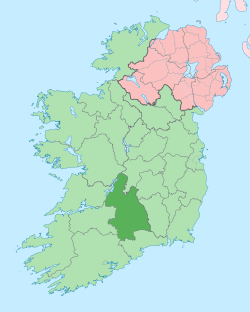
Back Tipperaryscīr ANG مقاطعة تيبيراري Arabic Condáu de Tipperary AST Типърари (графство) Bulgarian Kontelezh Tiobraid Árann Breton Comtat de Tipperary Catalan Hrabství Tipperary Czech Swydd Tipperary Welsh County Tipperary Danish County Tipperary German
County Tipperary
Contae Thiobraid Árann | |
|---|---|
| Nickname: The Premier County | |
 | |
| Country | Ireland |
| Province | Munster |
| Region | Southern |
| Shired[1] | 1328 |
| Divided | 1838 |
| Reunified | 2014 |
| County towns | Nenagh/Clonmel |
| Government | |
| • Local authority | Tipperary County Council |
| • Dáil constituency | Tipperary |
| • EP constituency | South |
| Area | |
| • Total | 4,305 km2 (1,662 sq mi) |
| • Rank | 6th |
| Highest elevation | 918 m (3,012 ft) |
| Population | |
| • Total | 167,895 |
| • Rank | 12th |
| • Density | 39/km2 (100/sq mi) |
| Time zone | UTC±0 (WET) |
| • Summer (DST) | UTC+1 (IST) |
| Eircode routing keys | E21, E25, E32, E34, E41, E45, E53, E91 (primarily) |
| Telephone area codes | 051, 0504, 0505, 052, 061, 062, 067 (primarily) |
| ISO 3166 code | IE-TA |
| Vehicle index mark code | T |
| Website | Official website |
 | |

County Tipperary (Irish: Contae Thiobraid Árann) is a county in Ireland. It is in the province of Munster and the Southern Region. The county is named after the town of Tipperary, and was established in the early 13th century, shortly after the Norman invasion of Ireland. It is Ireland's largest inland county and shares a border with eight counties, more than any other. The population of the county was 167,895 at the 2022 census.[3] The largest towns are Clonmel, Nenagh and Thurles.
Tipperary County Council is the local authority for the county. In 1838, County Tipperary was divided into two ridings, North and South. From 1899 until 2014, they had their own county councils. They were unified under the Local Government Reform Act 2014, which came into effect following the 2014 local elections on 3 June 2014.[4]
- ^ "Brief History of County Tipperary – Roots Ireland". rootsireland.ie. Archived from the original on 21 June 2019. Retrieved 21 June 2019.
- ^ "Census 2016 Sapmap Area: County Tipperary". Central Statistics Office (Ireland). Archived from the original on 18 November 2018. Retrieved 18 November 2018.
- ^ "Census 2022: Profile 1 - Population Distribution and Movement: F1001 - Population at Each Census". data.cso.ie. Retrieved 3 December 2023.
- ^ "Tipperary County Council". 29 May 2014. Archived from the original on 6 June 2014. Retrieved 3 June 2014.
Tipperary County Council will become an official unified authority on Tuesday, 3rd June 2014. The new authority combines the existing administration of North Tipperary County Council and South Tipperary County Council.
